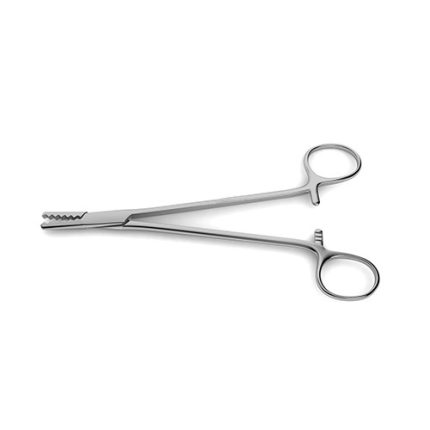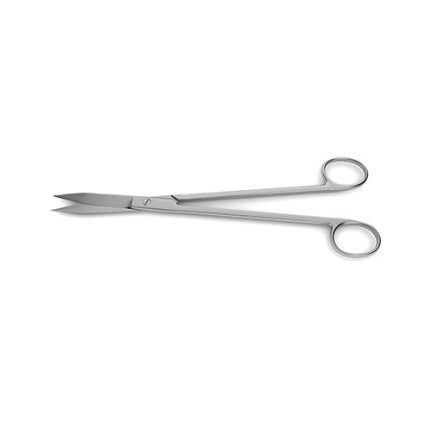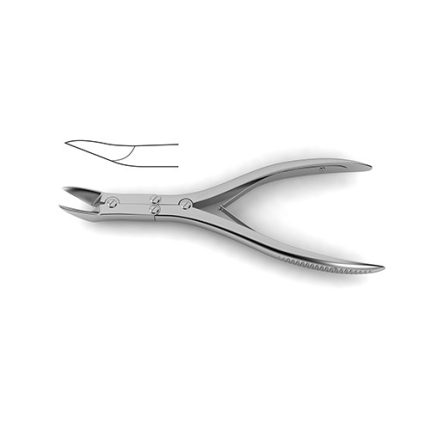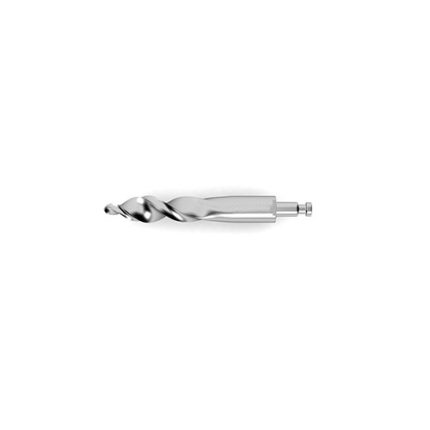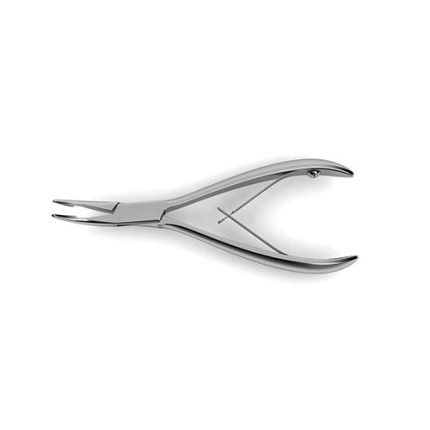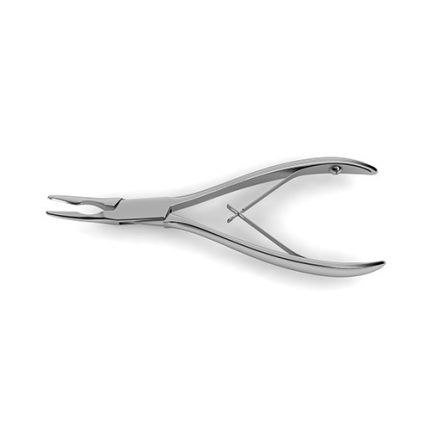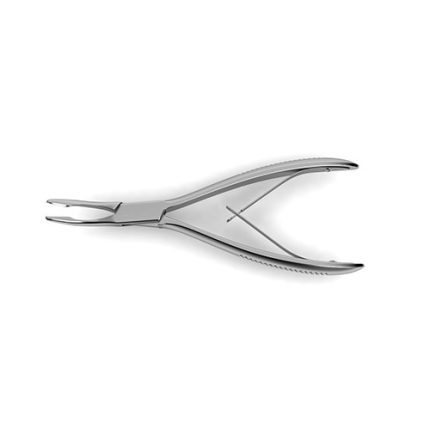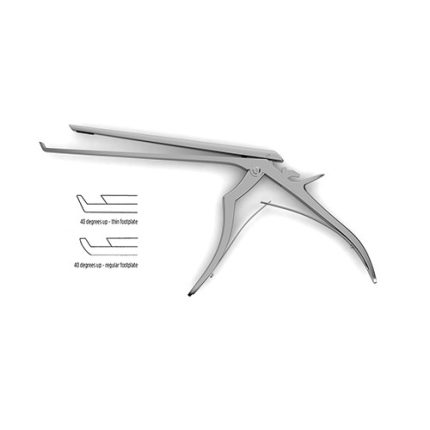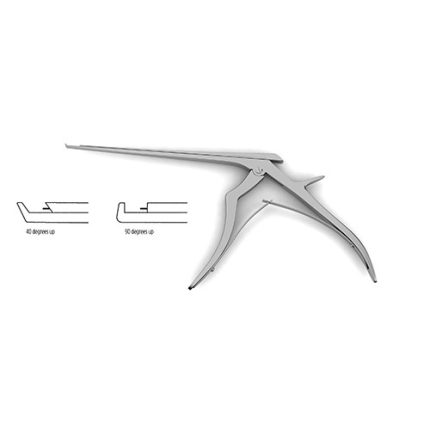Martin Cartilage Clamp
Martin Cartilage Clamp Martin Cartilage Clamp is a highly versatile instrument that can be used in variety of orthopedic procedures. Specifically it is designed to be used with cartilage and thus is more gentle than something crafted for use with bone. This clamp is ideal for procedures such as meniscus repair and other surgical repairs of torn cartilage. The ring handle grip as well as the zig-zag design of the teeth making this instrument easy to manipulate manually while keeping a sturdy grip on the cartilage. Additionally it is available in three lengths: 6.25", 7.25" and 8".
Martin Cartilage Scissors
Martin Cartilage Scissors
8" (20.3 cm), 2 serrated blades
Martin Cartilage Scissors are scissors suited for use in a number of different procedures. They can be used in orthopedic procedures that require bony repairs in areas that are cartilaginous and need remodeling. This instrument is 8" long and features two serrated blades that allows it to give accurate and precise cuts through the cartilage. It is available with either a straight or curved profile making it suitable for a variety of surgical scenarios and surgeon preferences.
McIndoe Bone Cutting Forceps
double-action, narrow pointed jaws, 7-1/8" (18.0 cm) Mcindoe Bone Cutting Forceps are ideal for use in surgeries that require clipping of bone. The spring handle design of this instrument makes it easy to handle and effective at providing quick and precise cutting. Additionally these forceps are double action and feature narrow pointed jaws which allows them to fit into narrow areas where smaller more delicate bones are located.
McKenzie Drill Bit
McKenzie Drill Bit
1/2" (13.0 mm)
McKenzie Drill bit is a unique instrument that can be used in conjunction with a drill to enlarge and create holes in bone. Specifically this can be useful in craniotomies and other neurosurgical procedures that require access through the bony skull to the soft underlying brain tissue. The head of this bit is similar to a typical spiral cut drill bit and easily penetrates bone.
Mead Ronguer
no. 1a pattern, slightly-curved beaks, 6-1/2" (16.5 cm)Mead Rongeur is an instrument used in orthopedic surgeries. This instrument is ideally suited for handling bone and cutting or trimming portions of smaller bones. The unique feature of this instrument is that it is in a number 1a pattern and thus features slightly-curved beaks. This slightly modification of the tip of the jaws allows an increased grip on bone and aid in gouging or scooping out of bony areas that are harder to reach with more traditional patterns.
Medium Kerrison Rongeur
Micro Friedman Rongeur – Delicate
delicate, 2.0 mm wide jaws, 6" (15.0 cm)Micro Friedman Rongeur is designed for use in a variety of surgical procedures that require manipulation and handling of bone. These rongeurs are of a delicate design which makes them well suited for use in more delicate bone areas. Procedures such as exploration of the ear canal or manipulation of bones in the nasal area or behind the eye in the orbit are all ideally done with this instrument. Additionally it features a spring handle as well as jaws that are slightly curved making them contoured for use without causing stab injuring to surrounding tissues. This instrument is available in two lengths 5.5 and 5.25 inches.
Micro Friedman Rongeur – Very Delicate
very delicate, 1.5 mm wide jaws, 5-1/2" (14.0 cm)Micro Friedman Rongeur is an instrument made for cutting and manipulating smaller bone areas in the body. This instrument is ideal for cutting or clipping smaller areas of dense fibrous tissue such as cartilage and bone. Additionally this rongeur is very delicate and features a 1.5 mm wide jaw. These rongeurs are available in two different profiles straight and curved making them well suited for any surgical maneuver or surgeon preference.
Micro Kerrison Detachable Rongeur
Micro Kerrison Detachable Rongeur is a specialized instrument ideally suited for use in laminectomy procedures. It features small handles and regular footplate and is 40 degrees up which allows it to comfortably maneuver in the narrow spaces in and around the vertebral column. Laminectomies are performed for a number of reasons. Some include increased access to a particular region of the spinal cord by removing the vertebral arch of a series of vertebrae or to reduce pressure on a particular portion of the vertebral column. This instrument is available in 7", 8" or 9" as well as in a variety of bite widths and with or without an ejector making it highly versatile and well suited for a number of surgical scenarios.
Micro Kerrison Ejector Rongeur
thin footplates, small handles Micro Kerrison Ejector Rongeur is identical to our popular Micro Kerrison model but with a small pin ejector that sits within the shaft that's designed to eject any material from within the column when the handle is released. This allows the shaft to remain clear and assists during decontamination and sterilization, ultimately preserving the life of the instrument.
Micro Kerrison Foraminotomy Rongeurs
regular footplates, large handles, strong 70 degrees up-curved shaft, 40 degree up bite, 8" (20.0 cm)
Micro Kerrison Foraminotomy Rongeurs are specialized instruments designed for use in laminectomies. The 70 degree up-curved shaft is ideal for better visualization and access needed in foraminotomy procedures. This rongeur features thin footplates and large handles, making it ideal for use in the narrow space surrounding the vertebral column. It is available in 2.0 – 5.0 mm bite in 1.0 mm increments to accommodate any surgical scenario.
Micro Kerrison Fully Detachable Rongeur
40 degrees up, small handles, 9.0 mm opening, thin footplate
Fully Detachable Rongeurs feature a fully-removable shaft to ensure no debris remain in the interior of the instrument after cleaning and sterilization. The instrument can be easily disassembled and reassembled in just a few seconds. By pushing the release button on the body, the front handle can be pulled down and the upper shaft can be pulled backwards and up to remove completely.


